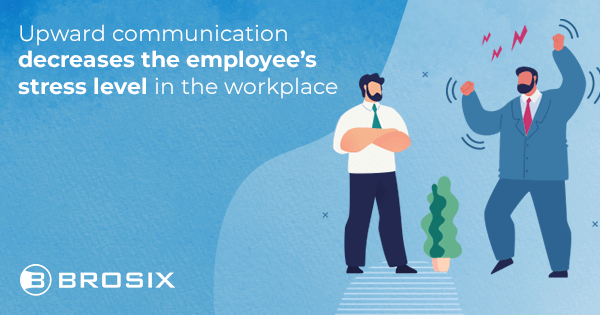As a result of the COVID-19 pandemic, life at the office as we knew it has changed, probably forever. Or at least until the next big thing hits us.
With so many different ways of working, from hybrid to fully remote working, big and smaller companies alike had to find new ways to maintain and improve employee communication processes. Improving communication skills across all levels of an organization can significantly enhance overall productivity and employee satisfaction.
This brings us to upward communication and how internal communication is mostly handled in today’s organizations.
Before we begin talking about the importance of upward communication, let’s first make sure we understand what upward communication actually is.
What Is Upward Communication?
Upward communication is the process in which subordinates directly communicate with upper management and speak their minds regarding various situations. Upward communication creates a participative environment, encouraging employees to provide feedback. This way, employees feel like they are an integral part of the decision-making process within a company.
Differences Between Upward and Downward Communication Methods
Unlike upward communication, downward communication is a communication strategy in which the flow of information is passed from direct managers to lower-level employees. It is often addressed as an order or instruction instead of a suggestion, as in the upward communication model.
In the past, most organizations were oriented toward downward communication practices. However, the massive change in the global work scene may be the spark that ignites the switch to an upward flow of communication.
Benefits of Upward Communication in the Workplace
As technology evolves, the old standard communication flows for both internal and external communication change too.
With the power of social media and the impact online communities can have on any brand and business, clearly the days of unilateral communication are long gone.
This is something that employees know and expect to happen both within and outside an organization. Internal communication, including both upward communication and open forums like company meetings, plays a key role in corporate health.
Upward communication encourages employee retention and increases productivity. It makes room for innovation and improvement.
It is important to mention that this type of communication has proven to be beneficial for both employees and organizations.
How is upward communication beneficial for employees?
-
Upward communication offers employees the chance to speak up and express their feelings on matters that concern them
All people want to have their voices heard, especially in situations that directly affect them. Employees can offer a wealth of knowledge; let’s not forget that they are the people actually doing the work each day. Listening to their feedback can provide insights and opportunities for a company to become more efficient, particularly regarding workflow.
An employee’s input is, above all, based on facts, and not taking into consideration their needs will only make it harder for them to execute their jobs and to maintain or even increase productivity.
That is the first, and maybe the most important reason why upward communication is crucial in an organization.
-
Upward communication decreases employee stress levels in the workplace
Did you know that in the US alone, 83% of workers said that workplace stress had caused difficulties, and 25% described these as having major effects on their lives?
Sure, people are different, and some employees may be more productive when they’re under a lot of pressure. But most of the time, this only applies to project-based tasks that happen once in a while.
In the long term, having a stressful environment will only disrupt an employee’s well-being, which is likely to negatively affect their productivity and overall the business’s success.
Here is where upward communication steps in. If not for its complete elimination, upward communication is a way for companies to massively reduce their employees’ stress.
-
Upward communication makes employees feel more appreciated and improves job satisfaction
Giving valuable input that is listened to, properly acted upon, and turns out to actually benefit the organization can do wonders for an employee’s self-esteem.
Making an employee feel valued will bring out the best in them. Which will only turn into greater motivation for the employee to evolve professionally. Let’s not forget that having aspirations is the engine that drives a person toward the best version of themself.
It is also important to mention that, according to the data, 80% of employees say that a strongly engaged culture enables them to do their best work.
How is upward communication beneficial for companies?
-
Upward communication is a determining factor for employee engagement and retention
If you have good employees, one of your main objectives as a company should be to retain them to make sure your organization’s success continues.
They deserve to be shown respect and gratitude because they have proven themselves of knowing how to accomplish their role with optimal results and in an optimized time frame.
In fact, highly engaged employees are 87% less likely to leave their workplace, looking for another job. Upward communication is a way of keeping them on board.
On that note, we should also mention that employee disengagement costs the U.S. economy $450-550 billion every year.
-
Upward communication helps managers find opportunities for both self-improvement and innovation within a company
Managing people is not easy. It requires both a set of professional and interpersonal skills. And just like any other employee, managers need to constantly work on themselves.
Upward communication is crucial for building transparent relationships and mutual trust, without which sincere and constructive feedback cannot be given.
Bidirectional feedback is also essential for innovation and should be applied to all levels of a company’s hierarchy. Since innovation leads to profitability, the chances are pretty high that a company using upward communication will be more successful in the long term than a company using only downward communication.
As data has revealed, having highly engaged employees leads to a 23% increase in profitability.
-
Upward communication improves workplace procedures
The best people at finding solutions are usually the ones directly confronting a problem. And since most of the execution and actual services a company offers are conducted by lower-level employees, it would only be natural for them to have expertise in this area.
Listening to the guidelines they have in mind could be the breakthrough point for a very costly problem for an organization. Surely optimizing costs is a matter that interests every business. Regarding both big and minor problems, upward communication not only benefits employees but also companies. For example, the proposal of working with more modern and digitalized apps like voice chats, video chats, individual chat rooms, or chat rooms for groups for a more unified communication process could help to optimize performance.
How Can Managers Communicate Upward?
To foster upward communication in an organization, upper management should consider a couple of different practices. Some will be related to how different soft and interpersonal skills are used, and others relate more to technical matters.
A couple of ways in which managers can foster upward communication in the workplace are:
- have an open-door policy
- be open and receptive
- foster a culture of participation
- encourage written feedback
- incorporate channels for employees to express their ideas and concerns
- measure employee engagement
- encourage employee-generated content
Ways of Actually Implementing Upward Communication
Reports and employee satisfaction surveys are common examples of upward communication.
In an organization that favors upward communication, performance reports are bidirectional. This means the performance of upper management is also evaluated by lower-level employees, not only the other way around.
The main difference between performance reports and employee satisfaction surveys is that the first focuses on evaluating the performance of specific individuals who are in the company’s hierarchy. However, employee satisfaction surveys are usually directed toward evaluating the overall company and workplace culture.
To emphasize the importance of these two forms of upward communication, did you know that 58% of employees wish their company conducted employee engagement surveys more frequently?
Use Upward Communication to Encourage Employee Branding
Employee branding is all about how an organization is seen from its employees’ perspective. It greatly impacts future employer branding programs and the company’s ability to recruit talented and skilled employees.
Since word of mouth remains one of the most powerful marketing tactics, imagine the benefits of having your employees as your main brand ambassadors. Trust me, there’s no more reliable source than that when evaluating a company.
Of course, building an excellent employee brand might never happen without inclusive upward communication strategies. It is truly a game-changer!
Use upward communication to gather a company-wide understanding of your employees’ expectations. Through this, your company can create a great employee experience, ultimately strengthening your brand image.
Conclusion
And there you have it! A complete guide to upward communication!
Upward communication is increasing in popularity today. A great way to start fostering an upward communication policy is by finding useful tools to facilitate your workplace communication flow.
Covering many needs with a multitude of software options available, Brosix may be just what you need to start implementing or upgrading your upward communication plan! Book a demo and give it a try!
FAQs
How does fostering upward communication benefit an organization?
Companies that foster upward communication benefit from increased employee engagement, improved morale, and better decision-making.
What are some other advantages of upward communication?
Additional benefits of upward communication include identifying issues or concerns early, fostering innovation, and enhancing overall communication effectiveness.
Why is fostering upward communication important?
Upward communication is participative, allowing for the creation of a more inclusive work environment. This provides a great way for employees to feel appreciated by sharing their ideas and feedback. It also helps address problems before they escalate.
Can you provide 5 examples of how to encourage upward communication within an organization?
Examples include setting up suggestion boxes, conducting regular feedback sessions, encouraging open-door policies, providing avenues for written feedback, and training employees on effective communication skills.
How does upward communication differ from downward communication?
Upward communication involves employees sharing information with their superiors, whereas downward communication is directive in nature.
What are some ways to foster upward communication within an organization?
The best way to foster upward communication includes creating a work culture that values open communication. It allows employees to speak freely and the upper management to review and act upon employee suggestions.










